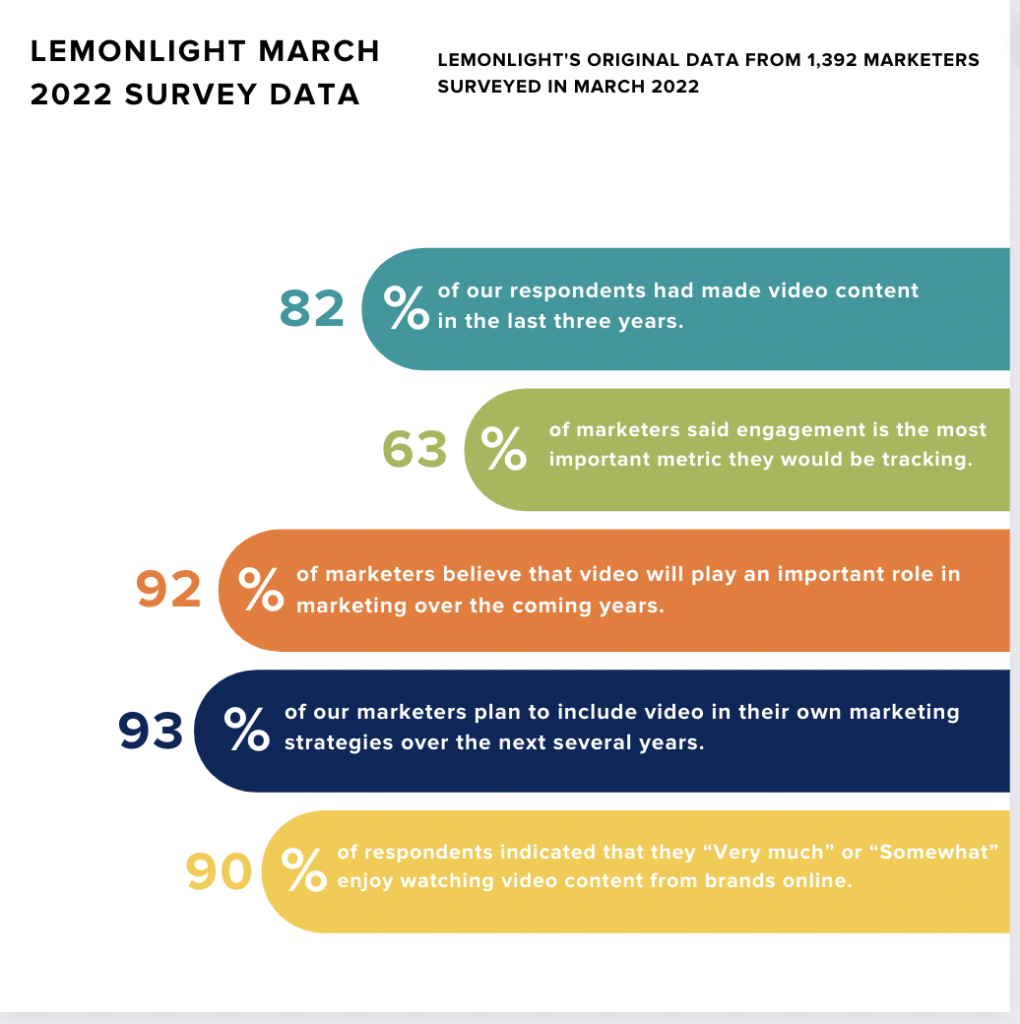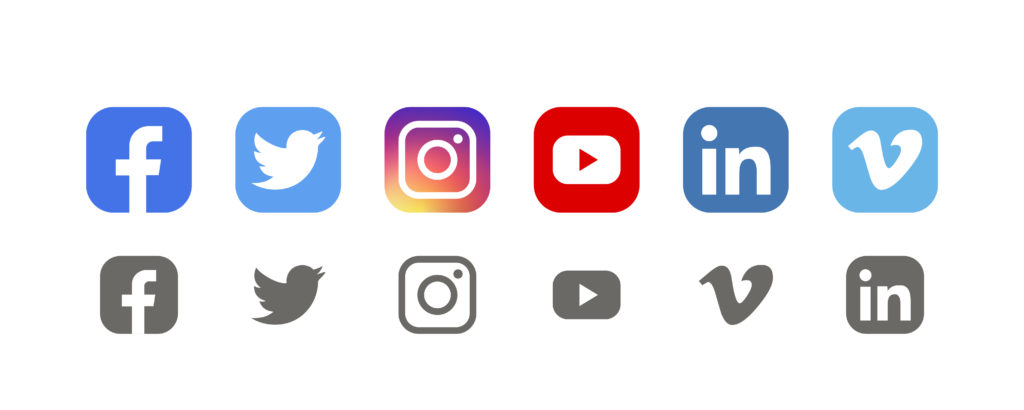[ad_1]
2023 is right around the corner, and as we say every year, video just keeps getting better. In the marketing world, it’s almost impossible to ignore video as we enter 2023. It’s simply everywhere—traditional broadcast spots, digital OOH placements, social ads, OTT, and countless other channels that are invaluable to marketing success.
Video raises the bar across owned, earned, and paid channels, and it’s expected to continue to dominate the marketing field in 2023. With that in mind, we’ll borrow a popular adage that’s especially relevant for the video space: “The best time to start was yesterday. The second-best time is now.”
In other words, if your business is still putting off video content for some unknown date in the future, you’re continuing to lose out on its many benefits right now. You may have even read last year’s version of this article, promising yourself you’d finally prioritize video for 2022. Well, 2022 came and went, and those that doubled down on video are reaping the rewards.
If you’re not quite convinced, here are 67 statistics that prove the importance of video marketing for 2023 and beyond—including original data from our team at Lemonlight. Check them out!
[Note: This page has been updated from 2022 to reflect the latest statistics for 2023.]
Video Marketing Statistics 2023
As you can probably guess from the size of this list, there are tons of stats about video content. So, to make this valuable info just a little bit more digestible, we’re going to break the statistics into the following categories:
- Lemonlight’s original research
- Stats by marketing goal (Attract, Engage, Nurture, Close, Delight)
- Stats by social channel (TikTok, YouTube, Facebook, Instagram, Twitter, LinkedIn)
- Stats for video marketing industry trends
- Stats for consumer video viewing habits
Let’s dive in!
Lemonlight Original Research
In March 2022, Lemonlight launched a video marketing survey to gain a deeper understanding of the ways our own audience interacts with video.
In years past, we had also noticed a gap in industry info when it came to production processes. Many video marketing statistics that are publicly available focus on how consumers interact with video and why marketing teams prioritize video, but very little information exists about how these teams are approaching the production process itself.
The statistics below came from our March 2022 survey, which received a total of 1392 responses from marketers across the country. We’ll be running the same survey in January 2023, followed by a comprehensive report that captures the state of video marketing and compares 2023 data to our 2022 data. Stay tuned for that report in Q2 2023!
In the meantime, here’s what we found to be relevant going into 2023:
Key Stats
- 82% of our respondents had made video content in the last three years, with about one-third of that group handling production internally and two-thirds seeking outside support.
- 63% of marketers said engagement is the most important metric they would be tracking, with traffic, conversion rate, watch time, impressions, and click-through rate almost being tied for second-place.
- 92% of marketers believe that video will play an important role in marketing over the coming years.
- 93% of our marketers plan to include video in their own marketing strategies over the next several years. This same response last year was chosen by 82% of marketers, highlighting that video is still on the rise.
- 90% of respondents indicated that they “Very much” or “Somewhat” enjoy watching video content from brands online, with less than 4% sharing that they don’t like watching brand video content at all.

Source: Lemonlight
Production Practices
- 36% of respondents plan to spend $2,500 or less on their projects, with 14% planning to spend $10,000 or more.
- 53% of marketers said they’d be creating an explainer or brand video this year, both of which typically share the story of how a brand came to be, what it stands for, and why consumers should care.
- 64% of respondents said that they currently share between one and four videos per month across various channels.
Video Distribution
- Website and social media platforms were the top two channels marketers preferred for video distribution.
- If respondents had to choose one social platform to distribute video content, 29% would choose LinkedIn, 19% would choose Facebook, and 24% would choose YouTube.
- When evaluating the success of a video campaign, most marketers said it depends on the type of video they are making.
Consumer Habits
- Only 4% of marketers shared that they don’t like watching brand video content at all.
- The top three platforms consumers report using to watch video content are YouTube, Instagram, and Facebook.
- 58% of consumers say they prefer to watch video content on a smartphone. Laptops came in second at 19%.
- The top two traits consumers report as important for an engaging video are clear messaging/storyline and authenticity.

Statistics for Video Marketing by Marketing Goal
Next, we wanted to explore video marketing statistics broken down by overarching marketing goals. As marketers know all too well, there are countless frameworks to conceptualize common marketing goals, and everyone’s marketing funnel will look a little bit different.
At Lemonlight, we use, “Attract, Engage, Nurture, Convert, Delight” to reflect our goals throughout the customer lifecycle. We’ve used that framework to break down the video stats below, but if you use another framework in your organization, you’ll see the overlap.
In short: video is incredibly useful for any marketing goal your organization is pursuing. (Quick note here: if you’re not sure how to use video to align with your 2023 marketing goals, there’s nothing our Producers love more than helping you find the right match! Schedule a call here to tap into our video expertise.)
If you’re not quite convinced of video’s power, here are the stats to back that up.
Using Video to Attract Your Audience
When it comes to attracting new customers, it makes sense that video content is effective. It combines visual imagery, sound, and extras like effects or text headings to paint a fuller picture of your concept than any one component alone. Plus, since video is dynamic, it grabs attention better than static images or walls of text. Here’s what we know about video for the attract stage.
- 84% of marketers say video has helped them generate leads. (Wyzowl)
- 85% of marketers say that video is an effective way to get attention online. (Animoto)
- Video ads were the #1 way consumers discovered a brand they later purchased from. (Animoto)
- Over 90% of people say they discover new brands or products on YouTube. (Google)

Using Video to Engage New Contacts
Once you’ve attracted your audience, the next step is to engage your new contacts. This stage is all about connection, and you might focus on channels like social media or email marketing to continue to build rapport with your audience. Video is great for the engage stage because it’s an authentic way for viewers to learn more about your organization without feeling pushed to make a purchase right away. Here are some stats about the engage stage.
- 86% of marketers say video has helped them increase traffic to their website. (Wyzowl)
- 83% of marketers say video has increased dwell time on their website. (Wyzowl)
Using Video to Nurture Prospective Customers
At the nurture stage, your aim is to continue to connect with your audience and show them why your product or service is the solution to their needs. But rather than focusing on pushing a sale, you’re using the nurture stage to build a relationship. Here are a few stats about how video serves the nurture stage.
- 94% of video marketers say video has helped increase user understanding of their product or service. (Wyzowl)
- Viewers claim they retain 95% of a message when obtained via video. (Social Media Week)

Using Video to Close Deals
Video is incredibly effective at converting prospects to customers. Why? Video often means that viewers can see your product or service in action, preemptively answering questions they might have had and demonstrating real-life applications. This is great for overcoming any final objections and bridging the gap between interest and purchase. Here are some stats to illustrate video’s effectiveness at conversion.
- More than half of shoppers say online video has helped them decide which specific brand or product to buy. (Google)
- 84% of people say that they’ve been convinced to buy a product or service by watching a brand’s video. (Wyzowl)
- 78% of marketers say video has directly helped to increase sales. (Wyzowl)
- 93% of brands got a new customer because of a video on social media. (Animoto)
Using Video to Delight Existing Customers
Last but not least, many brands forget to interact with their existing customers in order to ensure a perfect post-purchase experience and drive brand loyalty. Video accomplishes both! Post-purchase content can ensure that customers get the most out of their new product or service, and other touchpoints down the line continue to build the relationship and establish trust. Here are some stats to prove it.
- 93% of consumers find video helpful for post-purchase instructions. (Animoto)
- 43% of video marketers say video has reduced the number of support calls they’ve received. (Wyzowl)
Statistics for Video Marketing by Channel/Platform
Now that we’ve explored some video marketing stats broken down according to specific marketing goals, it’s time to look at stats broken down by marketing channels. We’ll focus primarily on various social media platforms because there’s so much to learn about the differences between them, but our final section at the end will cover non-social channels. First up: YouTube.

Video Stats for YouTube
- YouTube is the #1 purchase-driver on social. (Animoto)
- 87% of people say when shopping or browsing on YouTube, they feel like they can make a decision to purchase or not purchase faster. (Google)
- 83% of consumers worldwide prefer YouTube to watch video content. (Hubspot)
- 65% of video viewers say YouTube is their favorite channel for watching user-generated content. (Limelight)
- Over 40% of global shoppers say they have purchased products they discovered on YouTube. (Google)
Video Stats for Instagram
- 58% of people say they have become more interested in a brand or product after seeing it in Stories. (Instagram)
- 50% of people say they have visited a website to buy a product or service as a result of seeing it in Stories. (Instagram)
- 77% of marketers have posted a video on IGTV. (Animoto)
- 1 in 4 consumers made a purchase after seeing a story on Instagram. (Animoto)
Video Stats for Facebook
- The optimal video length for engagement on Facebook is between 2 and 5 minutes. (Social Insider)
- Accounts with over 100,000 Facebook followers post 71% of all video content. (Social Insider)
Video Stats for TikTok
- TikTok remains largely untapped, with only around 1 in 10 video marketers having given it a shot. Out of those who’ve tried it out, 66% report having seen success. (Wyzowl)
- 63% of all videos with the highest click-through rate highlight the key message or product within the first three seconds. (TikTok)
- TikToks shot vertically (9:16) have an average 25% higher 6-second watch-through rate than TikToks shot horizontally. (TikTok)
Video Stats for Twitter
- Tweets with video attract 10x more engagements than Tweets without video. (Twitter)
- Promoted Tweets with videos save more than 50% on cost-per-engagement. (Twitter)
- People watch 2 million videos on Twitter every day. (Hootsuite)
- Video consumption is the #3 reason people use Twitter. (Hootsuite)
Video Stats for LinkedIn
- LinkedIn users are 20x more likely to share a video than any other type of post. (LinkedIn)
- Content on LinkedIn designed for silent viewing is 70% more likely to be watched all the way through to the end. (LinkedIn)
Video Stats for Other Channels
- In 2020, streaming households eclipsed pay-TV households for the first time. (Nielsen)
- Five apps (Amazon Video, Disney+, Hulu, Netflix, and YouTube) account for 80% of all connected TV viewing. (Comscore)

Statistics for Video Marketing Industry Trends
Next, let’s take a look at some stats related to the video marketing industry more broadly. You might be wondering how your competitors are using video, what results other marketers are seeing from video, and where the industry is trending for 2023 and beyond. Here’s the info you’re looking for.
- 99% of marketers claim they will continue to use video in their approach. (Social Media Week)
- 88% of marketers are committed to devoting more dollars to video campaigns in the future. (Social Media Week)
- Video is the #1 form of media used in content strategy, overtaking blogs and infographics. (Hubspot)
- 86% of businesses now use video as a marketing tool. (Wyzowl)
- 46% of marketers are using live video as a social media tactic. (Hubspot)
- 94% of video marketers consider video an important part of their marketing strategy. (Wyzowl)
- 70% of businesses say they’re creating more videos now compared to the same time last year. (Animoto)
- 96% of marketers have placed ad spend on video. (Animoto)
- 16% of marketers who don’t currently use video say it’s because they lack the time. (Wyzowl)
- 17% of marketers who don’t currently use video say it’s because it’s too expensive. (Wyzowl)
- 17% of marketers who don’t currently use video say it’s because they don’t know where to start. (Wyzowl)
Statistics for Consumer Video Viewing Habits
Last but not least, we can’t explore video marketing stats for 2023 without exploring consumer viewing habits. The way viewers engage with video content has completely shifted in recent years, and the demand for brand video content is higher than ever. Don’t take our word for it—take a look at the stats below.
- 69% of people say they’d most prefer to learn about a new product or service by watching a short video. (Wyzowl)
- 85% of people would like to see more video from brands in 2021. (Wyzowl)
- 78% of people report watching videos online each week, with 55% of those watching on a daily basis. (Social Media Week)
- 88% of people say video helps ease collaboration and improves efficiency in the workplace. (Limelight)
- 84% of marketers rank video creation skills important when hiring for a new marketing position. (Animoto)
Conclusion
Hopefully, these 67 video marketing statistics for 2023 have convinced you that it’s important to include video in your content marketing plan. If so, click below to schedule a free consultation call with us! We’ll discuss your goals to come up with a video strategy that works for your audience, your goals, and your budget. We’re here to help!
[ad_2]
Source link









